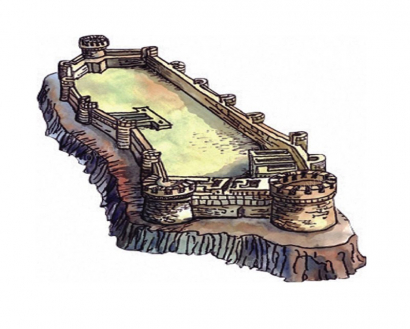Mysterious Monuments of Baku

Baku was first mentioned in the Book of the Dead during the first Egyptian Pharaoh Minesan in 3,500 BC. Near the city, in Absheron and Gobustan, Roman inscriptions and archaeological finds dating from 84-96 AD were discovered, and they prove the antiquity of Baku. Another important piece of evidence is a stone carving by August Guy Octavio, who reflected the stationing of a military camp under the rule of the Roman emperors Pompey and Lucius near Baku for the purposes of seizing the southern Caucasus in the 1st century BC. This means that Baku is nearly 5,500 years old.
It is natural to state that in a city with such an antiquity there will be a great number of historical monuments related to ancient and middle ages. However, in this article you will read about Baku's unknown monuments. The distinguishing feature of these monuments from others, for example, from the Maiden Tower, is that they are located far away from eyes.
Today tourists who are interested in the history of Azerbaijan mainly visit the Inner City. In this part of the city, tourists mainly visit the Shirvanshah Palace, the Maiden Tower, some mosques and winding roads. In fact, the Inner City's underground world has its own history. It is rich in interesting historical buildings. It includes underground public bathrooms, water basins with several rooms and secret ways about which legends are still spoken nowadays.
We often find out much information about secret underground ways as reserve ones under middle age cities and fortresses. Namely for this purpose, an underground way was constructed in the internal part of the northern fortress walls stretching till the Gosha Gala Gapilary, envisaged for the comfortable movement of soldiers. The underground way was connected to the tetragonal tower (weapon warehouse or donjon) from the West and East. Such a location of the tower was envisaged for soldiers' easy reaching the donjon for the taking of weapons. This underground way still keeps its own strategic and architectural significance. The underground way stretching along the fortress wall from the entrance gate of the "Icherisheher" subway station to the Gosha Gala Gapilary was closed because of opening the entrance doors to Icherisheher.
Another unseen secret of Baku is Bayil Tower. Today this construction is mainly named as 'Bayil Castle'. The fortress was built opposite the city in the XIII century in the Bayil bay, but due to the earthquake of 1306 the water level there dramatically increased, and the fortress found itself deep in water. Due to the sea level decline or increase, the castle came out or went down the sea. One can read much interesting information about it in "Farhadname" poem by Arif Erdebili. The castle was shaped in irregular rectangular. Its length is 180 metres, the width - 35 metres. The castle that has been under the sea for almost a century is the object of scientists' exploration today.
Long ago the scientists knew that the castle was under the Caspian Sea. In 1782, on the map of the Baku port designed by Russian cartographers it was stated that the process of taking the 'Bayil stones' out of the bottom of the sea had been started. The interest to the level of the Caspian Sea was more than that to the monument. Abbasgulu Agha Bakikhanov also gave interesting information about the castle.
According to the outcomes of the researches it was discovered that the castle was built in 1232-1233 near the coast of the Caspian Sea, on one of the Bayil's hills during the life of Fariburz, the son of Shirvanshah Garshasb, by the architect Abdul-Majid Masud oghlu. The name of the architect was graved on a stone. This architect also built the round castle in Mardakan, which was part of Abseron's integrated defence system, defending the city and Bayil Castle from the north. The structure of the stones used in the construction of the castle proves the high level of architecture in Azerbaijan almost eight centuries ago. The Shirvanshahs' names were chronologically graved on stones with their related symbols - symmetric human, animal, bird and mythic images.
The majority of professionals express the same opinion: "If Bayil Castle hadn't been hidden under the sea for four centuries, like other monuments of Absheron, it would have also lost its trace." During the archaeological excavation in 1939-1969, more than 700 stone stelae were taken out of the wall wrecks and from the bottom of the sea.
Today most part of Bayil Castle has undergone erosion. Only certain parts of the castle are safe. But this situation doesn't damage its architectural style and history.
Elmin NURİ
AND OTHER...
-
 Khagani Shirvani’s Creativity on the Literary Portal of England
Khagani Shirvani’s Creativity on the Literary Portal of England
“Write Out Loud”, the leading poetry portal of England, has posted in English the ghazal “A Love Song” by the great Azerbaijani poet Khagani Shirvani as part of the...
-
 Isi Malikzade’s Creativity on German Literature Magazine
Isi Malikzade’s Creativity on German Literature Magazine
LESERING.de, a popular German e-literature magazine, has posted in German the short story Salt by Isi Malikzade, the notable Azerbaijani writer, as part of the AzSTC project “Azerbaijan Literature in an International Virtual World”.
-
 Movlud Movlud’s Short Story on Turkish Portals
Movlud Movlud’s Short Story on Turkish Portals
“Detayhaberler.com”, “Dibace.net” and “Haber.232.com”, leading Turkish portals, have posted in Turkish the short story “We Have Already Grown Up” by the...









